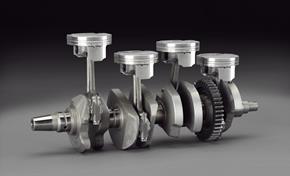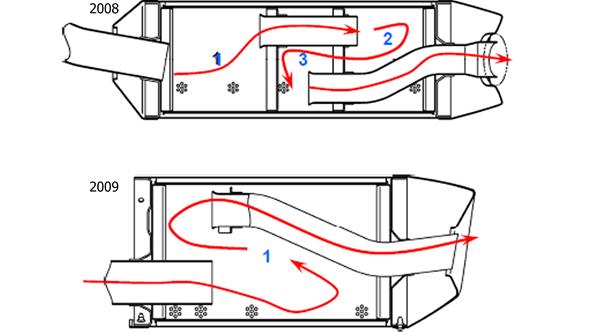Completely new crossplane crankshaft design to increase the throttle and drive ability by reducing the inertia force.

The crankpins are therefore in two planes crossed at 90°, thus the name crossplane crankshaft.
The crossplane crankshaft is designed to reduce inertia torque created by the engine to a minimum.
The torque that a rider feels is a combination of two kinds of torque: the Combustion torque coming directly from the firing of the engine, and the Inertia torque coming from the movement of the parts (such as pistons and crankshaft) inside the engine.
The inertia torque acts as ‘noise’ interfering with the combustion torque and thus throttle feeling for the driver.
Just like music we don’t want to have any cracks, hick-ups or other disturbances to interfere with the quality of the music. In other words we don’t want noise in the music!
With the crossplane design there is no noise anymore that disturbs the combustion torque. This results in a combined torque (combustion torque plus inertia torque) that is almost equal to the combustion torque and this improves the throttle feeling.
Previously the crossplane crankshaft has only been used on competition machinery due to the complex-shaped crankpins and crankshaft parts, as well as other factors including fluctuations in combustion torque pressure and levels of vibration. For these reasons this asymmetric engine layout has never been used before on mass-produced 4-cylinder supersport motorcycles.
Due to these special requirements and to absorb the inertia forces, the new crankshaft is built stronger and heavier than on previous R1 models.
 Crossplane 90° crankshaft: pistons rise and fall alone to spread the mass
Crossplane 90° crankshaft: pistons rise and fall alone to spread the mass Conventional 180° crankshaft: pistons rise and fall together
Conventional 180° crankshaft: pistons rise and fall togetherFirst we need to start with the force that each piston/crankshaft engine generates, that has influence on the throttle feeling of the engine. Each moving component generates forces when it accelerates and decelerates (F = m x a). The forces that occur try to keep the part moving in the direction it is going, while the part itself is slowing down. This is what we generally call inertia force.
The Inertia force is the sum of the total primary piston force plus the total secondary piston force.
A detailed explanation about these forces follows on the next 2 pages.

“The primary force is the inertia force produced by the piston mass due to the rotating crankpin’s projected movement along the line of stroke being relayed to the piston via the connecting rod.”
In other words: The maximum force that occurs every 180° when the piston is at TDC or at BDC and vice versa. Every object that is subjected to a change in speed or direction, generates a force that resists this change in speed or direction. At each dead centre this force is at its maximum and directed along the line of stroke, directed in the same direction that the object was moving.
When we look at a 4 cylinder in-line engine, we always have a “counter” force from another piston that is moving in the opposite direction, at the same time.
Example: piston 1 is moving down and at the same time piston 2 is moving up. Therefore the resultant of the both piston forces is in balance and thus cancel each other out.
This is the case for both a ‘conventional’ 180° crankshaft and for the crossplane crankshaft.
180° crankshaft:
Movie below: Primary 4 cylinder (180° crank):When piston 1 is at TDC, piston 2 is at BDC, and vice versa.
When piston 4 is at TDC, piston 3 is at BDC, and vice versa.
With this configuration you actually have two pistons moving in the same direction at the same time, and two other piston’s moving at the exact same time in the other direction. Both piston pair forces cancel each other out.
Crossplane crankshaft:
Movie below: Primary 4 cylinder (crossplane crank):
When piston 1 is at TDC, piston 4 is at BDC, and vice versa.
When piston 3 is at TDC, piston 2 is at BDC, and vice versa.
Although different pistons are now pairing up, the crossplane crankshaft gives the same result. In this construction one piston force cancels the other piston force out.

“The Secondary force is the inertia force produced by the piston mass due to the rotating crankpin’s outward and inward projected movement perpendicular (horizontally) to the line-of-stroke relaying motion to the piston via the inclining connecting rod.”
In other words: The conrod/crankpin is moving away from the line-of-stroke when it goes from TDC till 90° and then starts to move inwards to the line-of-stroke from 90° till BDC. The same conrod/crankpin movement is happening from BDC back to TDC; The conrod/crankpin moves away from the line-of-stroke from BDC till 270°, and moves inwards to the line-of-stroke from 270° till TDC. The secondary force is at its maximum at the moment the piston decelerates.
The secondary piston forces that are generated by this secondary movement are appearing at a different conrod/crankpin location than the primary piston forces. The timing of when each secondary piston force appears has a big influence when we compare the different 4 cylinder in-line crankshaft structures.
180° crankshaft:
Movie below: Secondary 4 cylinder (180° crank):
With this crankshaft structure all 4 pistons generate the secondary force in the same direction at the same time. 2 pistons move from TDC towards 90° and 2 other pistons move from BDC to 270°. It results in accumulating all the forces, because all forces are directed in one and the same direction. This is the total secondary force of this 180°crankshaft structure.
Crossplane crankshaft:
Movie below: Secondary 4 cylinder (crossplane crank):
With this crankshaft structure we have 4 pistons that are all in a different position from each other.
Two pistons are at the beginning of moving downwards, and two pistons are at the beginning of moving upwards.
Piston 1 is at TDC and moves to 90°, while piston 4 is at BDC and moves to 270°. Both these pistons generate a force that is directed upwards (Conrod outward movement) BUT Piston 2 is at 270° and moves to TDC, while piston 3 is at 90° and moves to BDC. Both these pistons generate a force that is directed downwards (Conrod inward movement).
This means that pistons 1 & 4 are a pair that have a force upwards and pistons 2 & 3 have a force directed downwards.
The forces that are directed upwards are cancelled out by the forces that are directed downwards.
This means that the crossplane crankshaft has no secondary force.

With the crossplane crankshaft design, the inertia force (= inertia torque) is reduced to almost zero (A little bit of noise remains due to flex and torsion from the crankshaft, because of absorbing the inertia force). So what remains is the ‘pure’ combustion torque. The feeling of the combustion torque is what is meant by throttle feeling. The combustion torque is no longer overruled by the inertia torque with the crossplane crankshaft. This gives the driver the feeling he is directly controlling the rear wheel without any interference, thus improving the ride ability.
Firing order The new crankshaft design results in a new ignition firing order.
This firing order gives the smoothest firing order possible with this crossplane structure.
The new firing order results in a new sequence of combustion: 1-3-2-4,
with the following intervals: 270° 180° 90° 180°.
So this is an ‘irregular’ firing engine compared to a normal 4-cylinder which fires with intervals 180° 180° 180° 180°.
Please see the movies regarding the firing of this engine.
[Right-click and choose "Save target as..." to download movie]
YCC-I Movie
Crossplane Movie

This means that exhaust system needs to be more ‘open’. The conventional 3-chamber mufflers (like previous R1 had) are creating a too high resistance to the airflow, so the crossplane R1 adopts a ‘mono-chamber’ exhaust layout as known from racing.
To keep the noise level within noise regulations, the muffler volume had to increase to a proportionally bigger size compared to 3-chamber layouts.
The adopted mono chamber design with the ‘unobstructed’ gas flow finally enables for top level performance and in addition creates a unique and exciting sound.
The lightweight titanium mufflers are located under the seat. That’s different from the R6, which has the muffler under the engine. This is because a certain exhaust pipe length is needed for torque characteristics, and because space is needed for the new ‘M1-type’ rear suspension system of the R1. This suspension system is developed to perfectly match the new engine characteristics and to support the traction out of corners.
Another example of Yamaha’s integrated development approach, where every detail counts!
source : http://www.yamaha-motor.eu







Post a Comment